A Comprehensive Comparison of Prokaryotic and Eukaryotic Cells
VerifiedAdded on 2023/06/15
|11
|2085
|187
Essay
AI Summary
This essay provides a detailed comparison of prokaryotic and eukaryotic cells, highlighting their structural and functional traits. It begins by defining cells as the basic units of life and emphasizes the importance of understanding cell structures to differentiate between prokaryotic and eukaryotic cells. ...

Prokaryotic and Eukaryotic Cells1
COMPARISON OF STRUCTURAL AND FUNCTIONAL TRAITS OF PROKARYOTIC AND EUKARYOTIC
CELLS
Author’s Name
Name of the course
Professor’s Name
Name of the institution
City and State where the institution is located
Date
COMPARISON OF STRUCTURAL AND FUNCTIONAL TRAITS OF PROKARYOTIC AND EUKARYOTIC
CELLS
Author’s Name
Name of the course
Professor’s Name
Name of the institution
City and State where the institution is located
Date
Paraphrase This Document
Need a fresh take? Get an instant paraphrase of this document with our AI Paraphraser
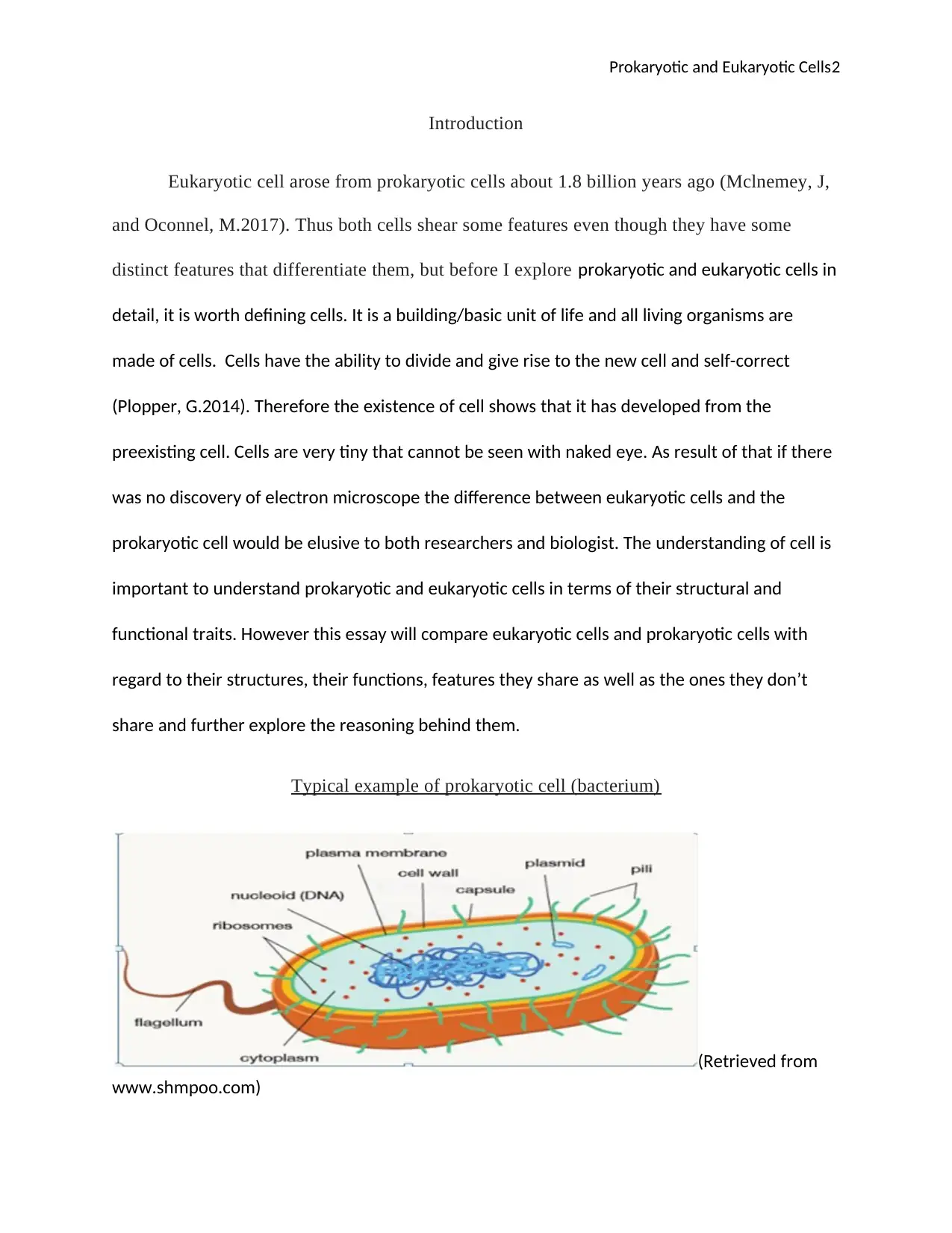
Prokaryotic and Eukaryotic Cells2
Introduction
Eukaryotic cell arose from prokaryotic cells about 1.8 billion years ago (Mclnemey, J,
and Oconnel, M.2017). Thus both cells shear some features even though they have some
distinct features that differentiate them, but before I explore prokaryotic and eukaryotic cells in
detail, it is worth defining cells. It is a building/basic unit of life and all living organisms are
made of cells. Cells have the ability to divide and give rise to the new cell and self-correct
(Plopper, G.2014). Therefore the existence of cell shows that it has developed from the
preexisting cell. Cells are very tiny that cannot be seen with naked eye. As result of that if there
was no discovery of electron microscope the difference between eukaryotic cells and the
prokaryotic cell would be elusive to both researchers and biologist. The understanding of cell is
important to understand prokaryotic and eukaryotic cells in terms of their structural and
functional traits. However this essay will compare eukaryotic cells and prokaryotic cells with
regard to their structures, their functions, features they share as well as the ones they don’t
share and further explore the reasoning behind them.
Typical example of prokaryotic cell (bacterium)
(Retrieved from
www.shmpoo.com)
Introduction
Eukaryotic cell arose from prokaryotic cells about 1.8 billion years ago (Mclnemey, J,
and Oconnel, M.2017). Thus both cells shear some features even though they have some
distinct features that differentiate them, but before I explore prokaryotic and eukaryotic cells in
detail, it is worth defining cells. It is a building/basic unit of life and all living organisms are
made of cells. Cells have the ability to divide and give rise to the new cell and self-correct
(Plopper, G.2014). Therefore the existence of cell shows that it has developed from the
preexisting cell. Cells are very tiny that cannot be seen with naked eye. As result of that if there
was no discovery of electron microscope the difference between eukaryotic cells and the
prokaryotic cell would be elusive to both researchers and biologist. The understanding of cell is
important to understand prokaryotic and eukaryotic cells in terms of their structural and
functional traits. However this essay will compare eukaryotic cells and prokaryotic cells with
regard to their structures, their functions, features they share as well as the ones they don’t
share and further explore the reasoning behind them.
Typical example of prokaryotic cell (bacterium)
(Retrieved from
www.shmpoo.com)
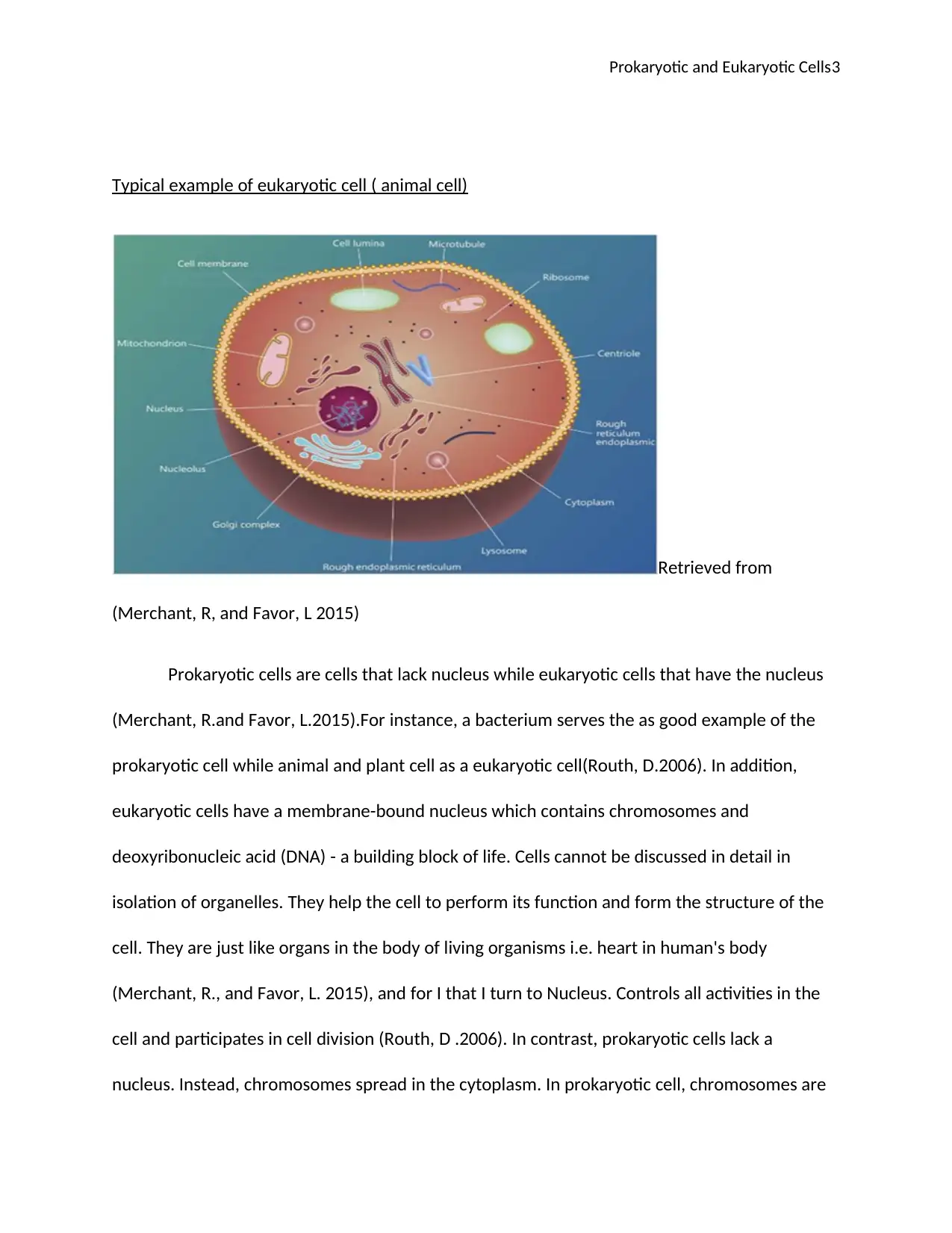
Prokaryotic and Eukaryotic Cells3
Typical example of eukaryotic cell ( animal cell)
Retrieved from
(Merchant, R, and Favor, L 2015)
Prokaryotic cells are cells that lack nucleus while eukaryotic cells that have the nucleus
(Merchant, R.and Favor, L.2015).For instance, a bacterium serves the as good example of the
prokaryotic cell while animal and plant cell as a eukaryotic cell(Routh, D.2006). In addition,
eukaryotic cells have a membrane-bound nucleus which contains chromosomes and
deoxyribonucleic acid (DNA) - a building block of life. Cells cannot be discussed in detail in
isolation of organelles. They help the cell to perform its function and form the structure of the
cell. They are just like organs in the body of living organisms i.e. heart in human's body
(Merchant, R., and Favor, L. 2015), and for I that I turn to Nucleus. Controls all activities in the
cell and participates in cell division (Routh, D .2006). In contrast, prokaryotic cells lack a
nucleus. Instead, chromosomes spread in the cytoplasm. In prokaryotic cell, chromosomes are
Typical example of eukaryotic cell ( animal cell)
Retrieved from
(Merchant, R, and Favor, L 2015)
Prokaryotic cells are cells that lack nucleus while eukaryotic cells that have the nucleus
(Merchant, R.and Favor, L.2015).For instance, a bacterium serves the as good example of the
prokaryotic cell while animal and plant cell as a eukaryotic cell(Routh, D.2006). In addition,
eukaryotic cells have a membrane-bound nucleus which contains chromosomes and
deoxyribonucleic acid (DNA) - a building block of life. Cells cannot be discussed in detail in
isolation of organelles. They help the cell to perform its function and form the structure of the
cell. They are just like organs in the body of living organisms i.e. heart in human's body
(Merchant, R., and Favor, L. 2015), and for I that I turn to Nucleus. Controls all activities in the
cell and participates in cell division (Routh, D .2006). In contrast, prokaryotic cells lack a
nucleus. Instead, chromosomes spread in the cytoplasm. In prokaryotic cell, chromosomes are
⊘ This is a preview!⊘
Do you want full access?
Subscribe today to unlock all pages.

Trusted by 1+ million students worldwide
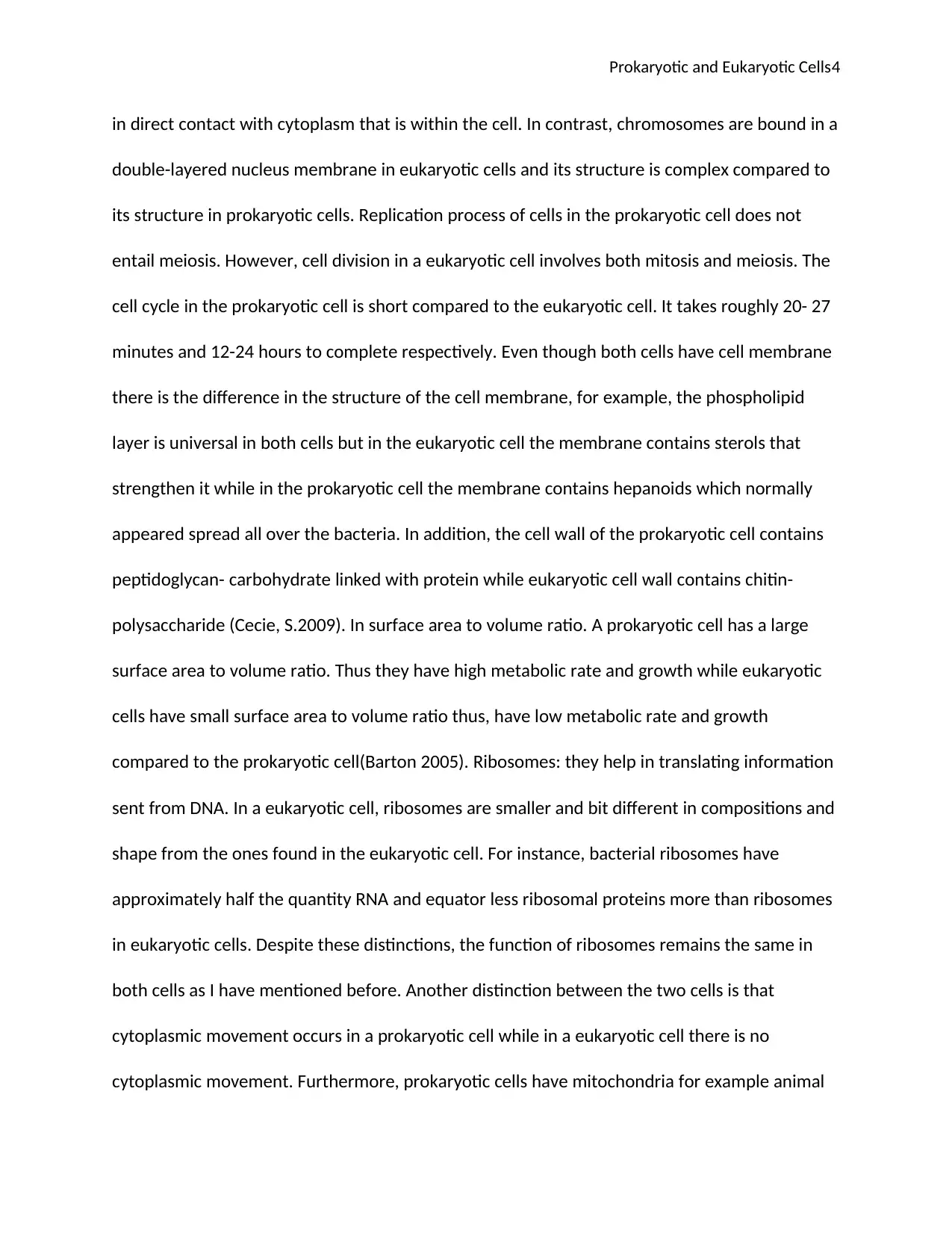
Prokaryotic and Eukaryotic Cells4
in direct contact with cytoplasm that is within the cell. In contrast, chromosomes are bound in a
double-layered nucleus membrane in eukaryotic cells and its structure is complex compared to
its structure in prokaryotic cells. Replication process of cells in the prokaryotic cell does not
entail meiosis. However, cell division in a eukaryotic cell involves both mitosis and meiosis. The
cell cycle in the prokaryotic cell is short compared to the eukaryotic cell. It takes roughly 20- 27
minutes and 12-24 hours to complete respectively. Even though both cells have cell membrane
there is the difference in the structure of the cell membrane, for example, the phospholipid
layer is universal in both cells but in the eukaryotic cell the membrane contains sterols that
strengthen it while in the prokaryotic cell the membrane contains hepanoids which normally
appeared spread all over the bacteria. In addition, the cell wall of the prokaryotic cell contains
peptidoglycan- carbohydrate linked with protein while eukaryotic cell wall contains chitin-
polysaccharide (Cecie, S.2009). In surface area to volume ratio. A prokaryotic cell has a large
surface area to volume ratio. Thus they have high metabolic rate and growth while eukaryotic
cells have small surface area to volume ratio thus, have low metabolic rate and growth
compared to the prokaryotic cell(Barton 2005). Ribosomes: they help in translating information
sent from DNA. In a eukaryotic cell, ribosomes are smaller and bit different in compositions and
shape from the ones found in the eukaryotic cell. For instance, bacterial ribosomes have
approximately half the quantity RNA and equator less ribosomal proteins more than ribosomes
in eukaryotic cells. Despite these distinctions, the function of ribosomes remains the same in
both cells as I have mentioned before. Another distinction between the two cells is that
cytoplasmic movement occurs in a prokaryotic cell while in a eukaryotic cell there is no
cytoplasmic movement. Furthermore, prokaryotic cells have mitochondria for example animal
in direct contact with cytoplasm that is within the cell. In contrast, chromosomes are bound in a
double-layered nucleus membrane in eukaryotic cells and its structure is complex compared to
its structure in prokaryotic cells. Replication process of cells in the prokaryotic cell does not
entail meiosis. However, cell division in a eukaryotic cell involves both mitosis and meiosis. The
cell cycle in the prokaryotic cell is short compared to the eukaryotic cell. It takes roughly 20- 27
minutes and 12-24 hours to complete respectively. Even though both cells have cell membrane
there is the difference in the structure of the cell membrane, for example, the phospholipid
layer is universal in both cells but in the eukaryotic cell the membrane contains sterols that
strengthen it while in the prokaryotic cell the membrane contains hepanoids which normally
appeared spread all over the bacteria. In addition, the cell wall of the prokaryotic cell contains
peptidoglycan- carbohydrate linked with protein while eukaryotic cell wall contains chitin-
polysaccharide (Cecie, S.2009). In surface area to volume ratio. A prokaryotic cell has a large
surface area to volume ratio. Thus they have high metabolic rate and growth while eukaryotic
cells have small surface area to volume ratio thus, have low metabolic rate and growth
compared to the prokaryotic cell(Barton 2005). Ribosomes: they help in translating information
sent from DNA. In a eukaryotic cell, ribosomes are smaller and bit different in compositions and
shape from the ones found in the eukaryotic cell. For instance, bacterial ribosomes have
approximately half the quantity RNA and equator less ribosomal proteins more than ribosomes
in eukaryotic cells. Despite these distinctions, the function of ribosomes remains the same in
both cells as I have mentioned before. Another distinction between the two cells is that
cytoplasmic movement occurs in a prokaryotic cell while in a eukaryotic cell there is no
cytoplasmic movement. Furthermore, prokaryotic cells have mitochondria for example animal
Paraphrase This Document
Need a fresh take? Get an instant paraphrase of this document with our AI Paraphraser
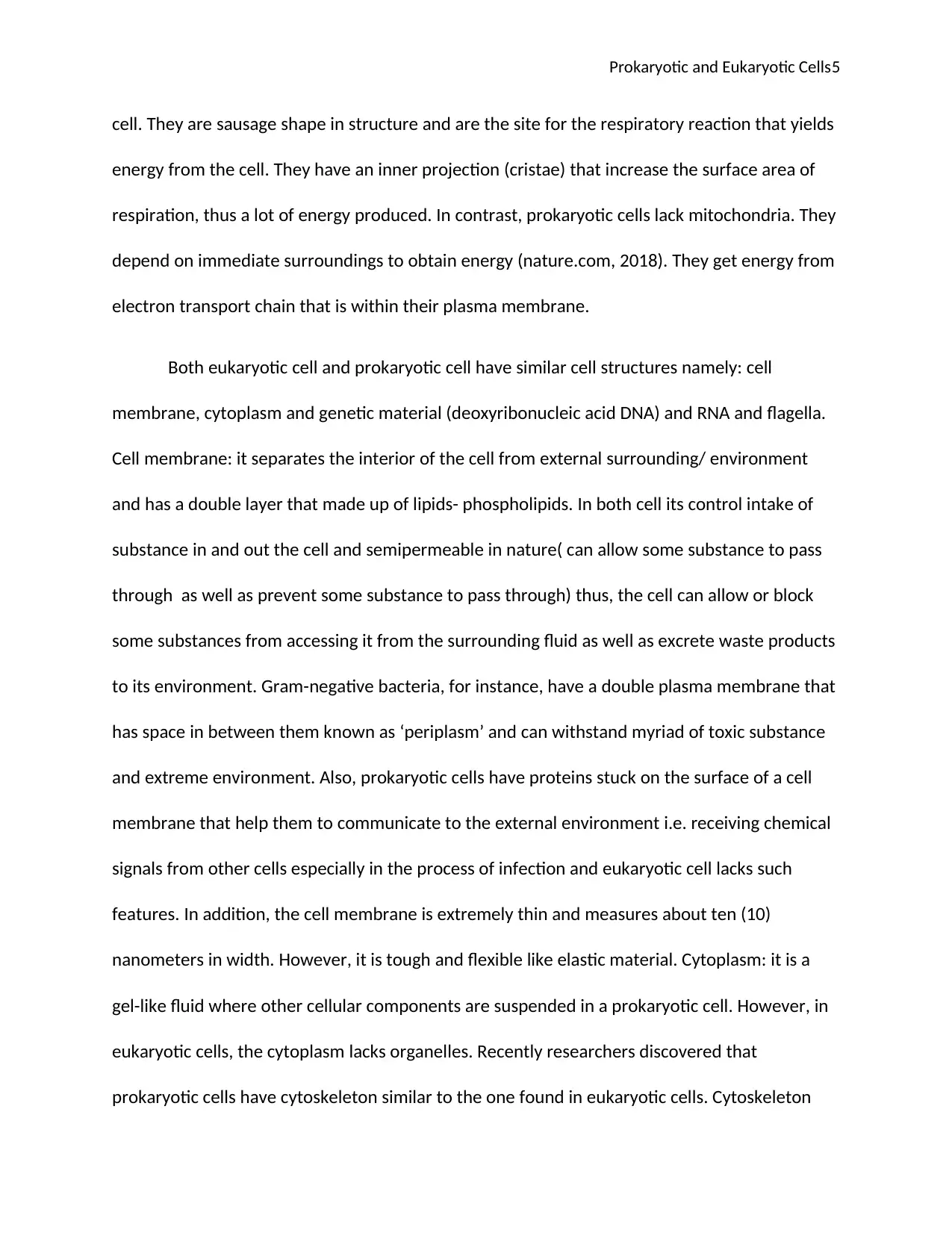
Prokaryotic and Eukaryotic Cells5
cell. They are sausage shape in structure and are the site for the respiratory reaction that yields
energy from the cell. They have an inner projection (cristae) that increase the surface area of
respiration, thus a lot of energy produced. In contrast, prokaryotic cells lack mitochondria. They
depend on immediate surroundings to obtain energy (nature.com, 2018). They get energy from
electron transport chain that is within their plasma membrane.
Both eukaryotic cell and prokaryotic cell have similar cell structures namely: cell
membrane, cytoplasm and genetic material (deoxyribonucleic acid DNA) and RNA and flagella.
Cell membrane: it separates the interior of the cell from external surrounding/ environment
and has a double layer that made up of lipids- phospholipids. In both cell its control intake of
substance in and out the cell and semipermeable in nature( can allow some substance to pass
through as well as prevent some substance to pass through) thus, the cell can allow or block
some substances from accessing it from the surrounding fluid as well as excrete waste products
to its environment. Gram-negative bacteria, for instance, have a double plasma membrane that
has space in between them known as ‘periplasm’ and can withstand myriad of toxic substance
and extreme environment. Also, prokaryotic cells have proteins stuck on the surface of a cell
membrane that help them to communicate to the external environment i.e. receiving chemical
signals from other cells especially in the process of infection and eukaryotic cell lacks such
features. In addition, the cell membrane is extremely thin and measures about ten (10)
nanometers in width. However, it is tough and flexible like elastic material. Cytoplasm: it is a
gel-like fluid where other cellular components are suspended in a prokaryotic cell. However, in
eukaryotic cells, the cytoplasm lacks organelles. Recently researchers discovered that
prokaryotic cells have cytoskeleton similar to the one found in eukaryotic cells. Cytoskeleton
cell. They are sausage shape in structure and are the site for the respiratory reaction that yields
energy from the cell. They have an inner projection (cristae) that increase the surface area of
respiration, thus a lot of energy produced. In contrast, prokaryotic cells lack mitochondria. They
depend on immediate surroundings to obtain energy (nature.com, 2018). They get energy from
electron transport chain that is within their plasma membrane.
Both eukaryotic cell and prokaryotic cell have similar cell structures namely: cell
membrane, cytoplasm and genetic material (deoxyribonucleic acid DNA) and RNA and flagella.
Cell membrane: it separates the interior of the cell from external surrounding/ environment
and has a double layer that made up of lipids- phospholipids. In both cell its control intake of
substance in and out the cell and semipermeable in nature( can allow some substance to pass
through as well as prevent some substance to pass through) thus, the cell can allow or block
some substances from accessing it from the surrounding fluid as well as excrete waste products
to its environment. Gram-negative bacteria, for instance, have a double plasma membrane that
has space in between them known as ‘periplasm’ and can withstand myriad of toxic substance
and extreme environment. Also, prokaryotic cells have proteins stuck on the surface of a cell
membrane that help them to communicate to the external environment i.e. receiving chemical
signals from other cells especially in the process of infection and eukaryotic cell lacks such
features. In addition, the cell membrane is extremely thin and measures about ten (10)
nanometers in width. However, it is tough and flexible like elastic material. Cytoplasm: it is a
gel-like fluid where other cellular components are suspended in a prokaryotic cell. However, in
eukaryotic cells, the cytoplasm lacks organelles. Recently researchers discovered that
prokaryotic cells have cytoskeleton similar to the one found in eukaryotic cells. Cytoskeleton
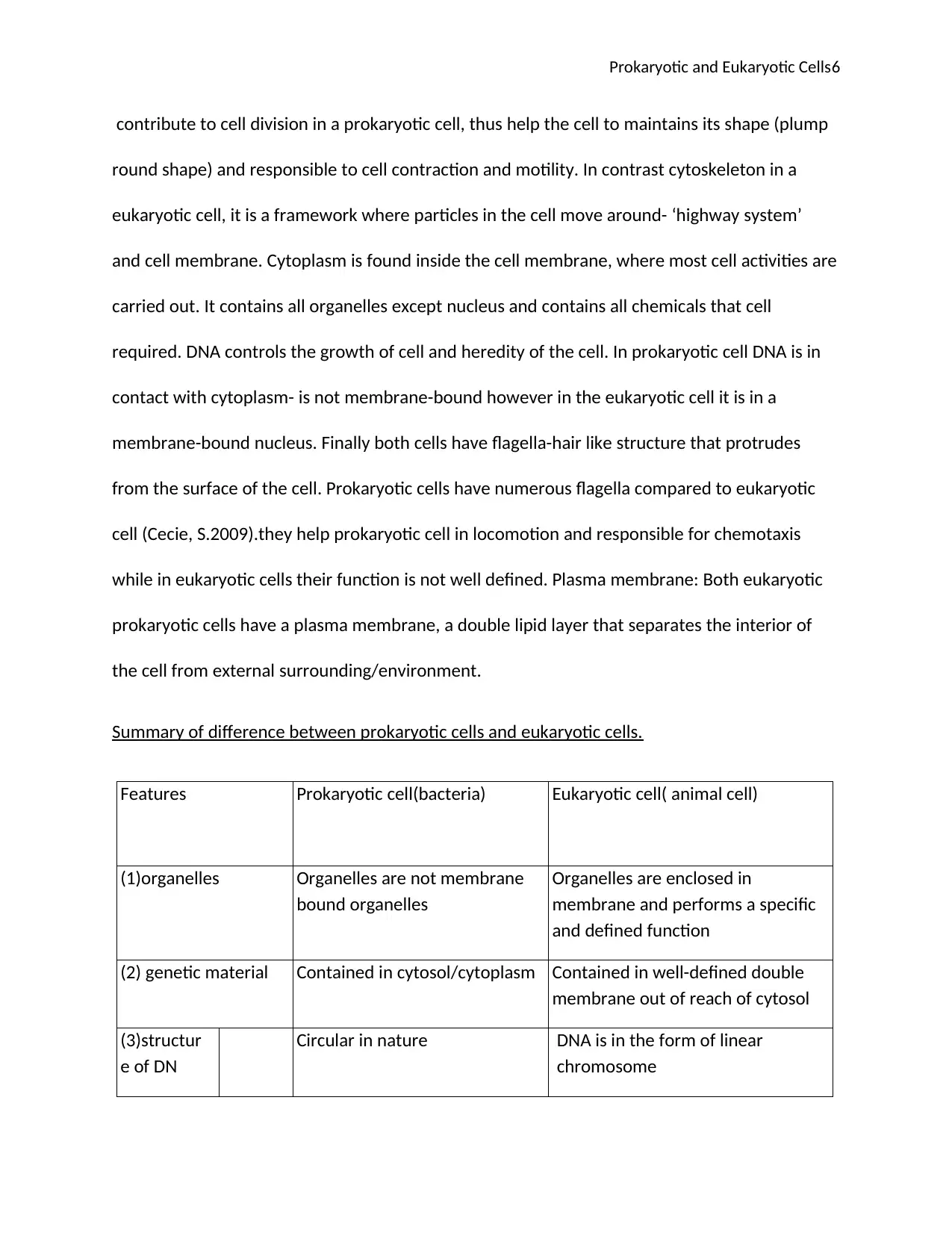
Prokaryotic and Eukaryotic Cells6
contribute to cell division in a prokaryotic cell, thus help the cell to maintains its shape (plump
round shape) and responsible to cell contraction and motility. In contrast cytoskeleton in a
eukaryotic cell, it is a framework where particles in the cell move around- ‘highway system’
and cell membrane. Cytoplasm is found inside the cell membrane, where most cell activities are
carried out. It contains all organelles except nucleus and contains all chemicals that cell
required. DNA controls the growth of cell and heredity of the cell. In prokaryotic cell DNA is in
contact with cytoplasm- is not membrane-bound however in the eukaryotic cell it is in a
membrane-bound nucleus. Finally both cells have flagella-hair like structure that protrudes
from the surface of the cell. Prokaryotic cells have numerous flagella compared to eukaryotic
cell (Cecie, S.2009).they help prokaryotic cell in locomotion and responsible for chemotaxis
while in eukaryotic cells their function is not well defined. Plasma membrane: Both eukaryotic
prokaryotic cells have a plasma membrane, a double lipid layer that separates the interior of
the cell from external surrounding/environment.
Summary of difference between prokaryotic cells and eukaryotic cells.
Features Prokaryotic cell(bacteria) Eukaryotic cell( animal cell)
(1)organelles Organelles are not membrane
bound organelles
Organelles are enclosed in
membrane and performs a specific
and defined function
(2) genetic material Contained in cytosol/cytoplasm Contained in well-defined double
membrane out of reach of cytosol
(3)structur
e of DN
Circular in nature DNA is in the form of linear
chromosome
contribute to cell division in a prokaryotic cell, thus help the cell to maintains its shape (plump
round shape) and responsible to cell contraction and motility. In contrast cytoskeleton in a
eukaryotic cell, it is a framework where particles in the cell move around- ‘highway system’
and cell membrane. Cytoplasm is found inside the cell membrane, where most cell activities are
carried out. It contains all organelles except nucleus and contains all chemicals that cell
required. DNA controls the growth of cell and heredity of the cell. In prokaryotic cell DNA is in
contact with cytoplasm- is not membrane-bound however in the eukaryotic cell it is in a
membrane-bound nucleus. Finally both cells have flagella-hair like structure that protrudes
from the surface of the cell. Prokaryotic cells have numerous flagella compared to eukaryotic
cell (Cecie, S.2009).they help prokaryotic cell in locomotion and responsible for chemotaxis
while in eukaryotic cells their function is not well defined. Plasma membrane: Both eukaryotic
prokaryotic cells have a plasma membrane, a double lipid layer that separates the interior of
the cell from external surrounding/environment.
Summary of difference between prokaryotic cells and eukaryotic cells.
Features Prokaryotic cell(bacteria) Eukaryotic cell( animal cell)
(1)organelles Organelles are not membrane
bound organelles
Organelles are enclosed in
membrane and performs a specific
and defined function
(2) genetic material Contained in cytosol/cytoplasm Contained in well-defined double
membrane out of reach of cytosol
(3)structur
e of DN
Circular in nature DNA is in the form of linear
chromosome
⊘ This is a preview!⊘
Do you want full access?
Subscribe today to unlock all pages.

Trusted by 1+ million students worldwide
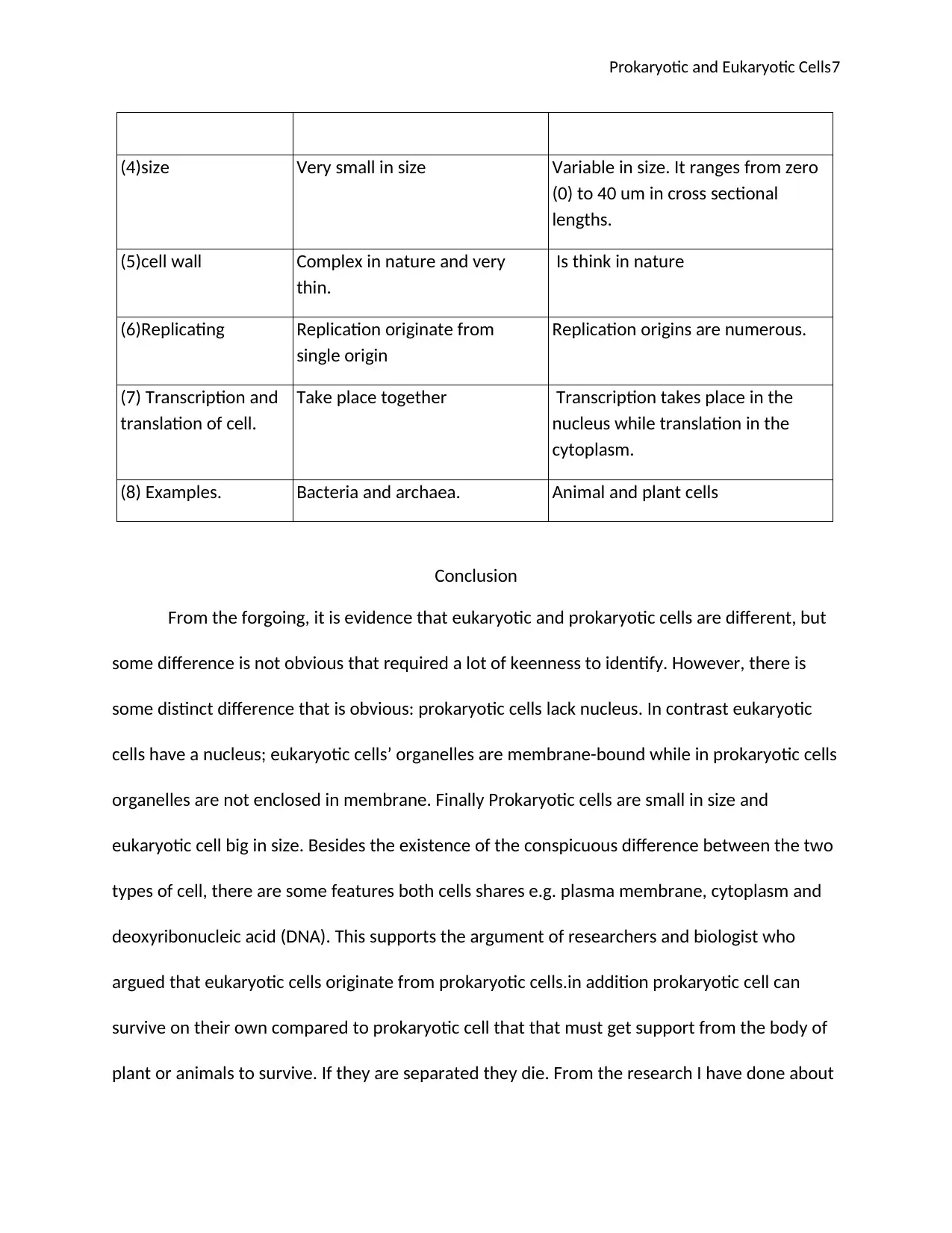
Prokaryotic and Eukaryotic Cells7
(4)size Very small in size Variable in size. It ranges from zero
(0) to 40 um in cross sectional
lengths.
(5)cell wall Complex in nature and very
thin.
Is think in nature
(6)Replicating Replication originate from
single origin
Replication origins are numerous.
(7) Transcription and
translation of cell.
Take place together Transcription takes place in the
nucleus while translation in the
cytoplasm.
(8) Examples. Bacteria and archaea. Animal and plant cells
Conclusion
From the forgoing, it is evidence that eukaryotic and prokaryotic cells are different, but
some difference is not obvious that required a lot of keenness to identify. However, there is
some distinct difference that is obvious: prokaryotic cells lack nucleus. In contrast eukaryotic
cells have a nucleus; eukaryotic cells’ organelles are membrane-bound while in prokaryotic cells
organelles are not enclosed in membrane. Finally Prokaryotic cells are small in size and
eukaryotic cell big in size. Besides the existence of the conspicuous difference between the two
types of cell, there are some features both cells shares e.g. plasma membrane, cytoplasm and
deoxyribonucleic acid (DNA). This supports the argument of researchers and biologist who
argued that eukaryotic cells originate from prokaryotic cells.in addition prokaryotic cell can
survive on their own compared to prokaryotic cell that that must get support from the body of
plant or animals to survive. If they are separated they die. From the research I have done about
(4)size Very small in size Variable in size. It ranges from zero
(0) to 40 um in cross sectional
lengths.
(5)cell wall Complex in nature and very
thin.
Is think in nature
(6)Replicating Replication originate from
single origin
Replication origins are numerous.
(7) Transcription and
translation of cell.
Take place together Transcription takes place in the
nucleus while translation in the
cytoplasm.
(8) Examples. Bacteria and archaea. Animal and plant cells
Conclusion
From the forgoing, it is evidence that eukaryotic and prokaryotic cells are different, but
some difference is not obvious that required a lot of keenness to identify. However, there is
some distinct difference that is obvious: prokaryotic cells lack nucleus. In contrast eukaryotic
cells have a nucleus; eukaryotic cells’ organelles are membrane-bound while in prokaryotic cells
organelles are not enclosed in membrane. Finally Prokaryotic cells are small in size and
eukaryotic cell big in size. Besides the existence of the conspicuous difference between the two
types of cell, there are some features both cells shares e.g. plasma membrane, cytoplasm and
deoxyribonucleic acid (DNA). This supports the argument of researchers and biologist who
argued that eukaryotic cells originate from prokaryotic cells.in addition prokaryotic cell can
survive on their own compared to prokaryotic cell that that must get support from the body of
plant or animals to survive. If they are separated they die. From the research I have done about
Paraphrase This Document
Need a fresh take? Get an instant paraphrase of this document with our AI Paraphraser

Prokaryotic and Eukaryotic Cells8
the topic of this task, less books and articles give good insight of distinction between
prokaryotic cells eukaryotic cells. Therefor more books and articles needs to be published
concerning the topic above.
Reference
the topic of this task, less books and articles give good insight of distinction between
prokaryotic cells eukaryotic cells. Therefor more books and articles needs to be published
concerning the topic above.
Reference
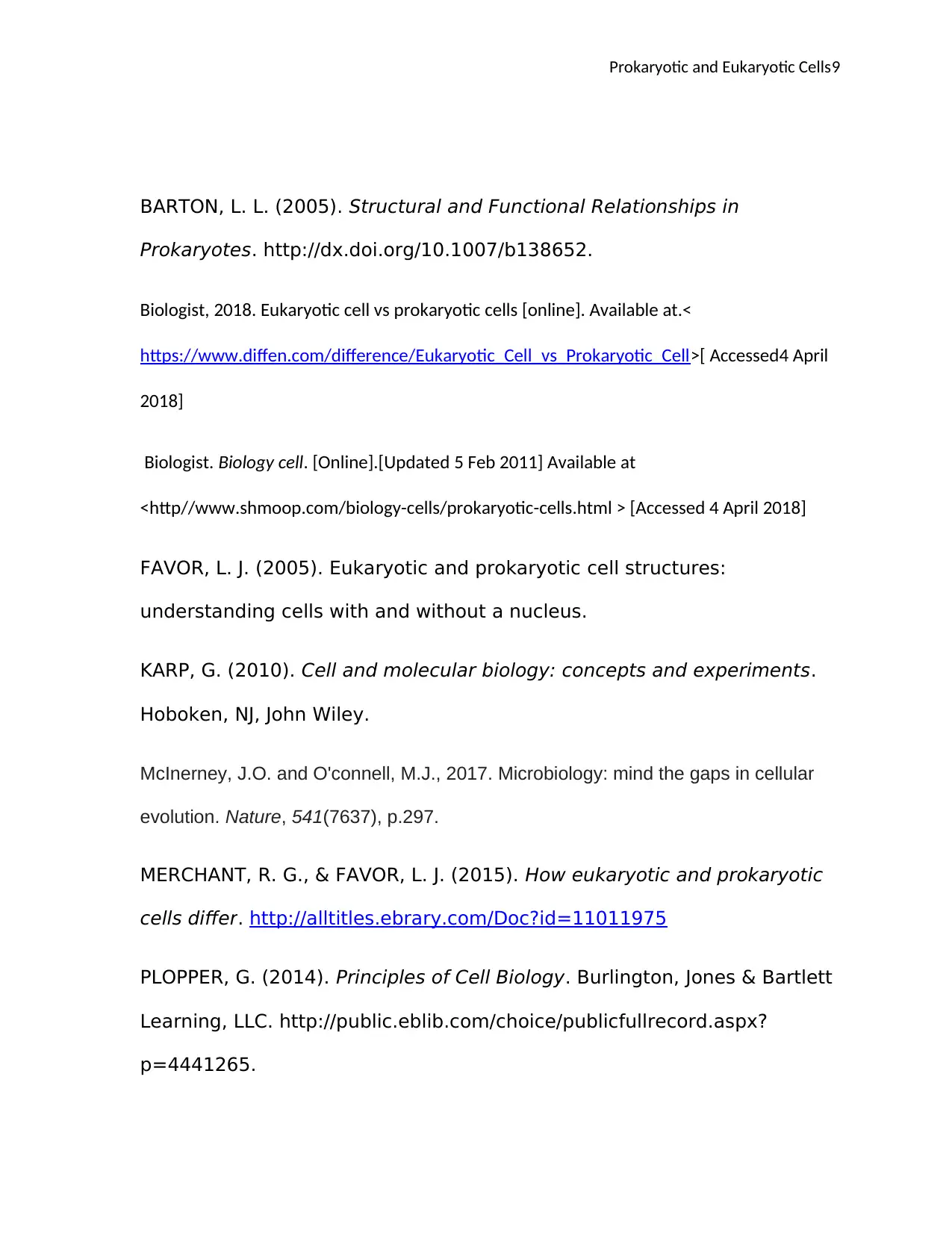
Prokaryotic and Eukaryotic Cells9
BARTON, L. L. (2005). Structural and Functional Relationships in
Prokaryotes. http://dx.doi.org/10.1007/b138652.
Biologist, 2018. Eukaryotic cell vs prokaryotic cells [online]. Available at.<
https://www.diffen.com/difference/Eukaryotic_Cell_vs_Prokaryotic_Cell>[ Accessed4 April
2018]
Biologist. Biology cell. [Online].[Updated 5 Feb 2011] Available at
<http//www.shmoop.com/biology-cells/prokaryotic-cells.html > [Accessed 4 April 2018]
FAVOR, L. J. (2005). Eukaryotic and prokaryotic cell structures:
understanding cells with and without a nucleus.
KARP, G. (2010). Cell and molecular biology: concepts and experiments.
Hoboken, NJ, John Wiley.
McInerney, J.O. and O'connell, M.J., 2017. Microbiology: mind the gaps in cellular
evolution. Nature, 541(7637), p.297.
MERCHANT, R. G., & FAVOR, L. J. (2015). How eukaryotic and prokaryotic
cells differ. http://alltitles.ebrary.com/Doc?id=11011975
PLOPPER, G. (2014). Principles of Cell Biology. Burlington, Jones & Bartlett
Learning, LLC. http://public.eblib.com/choice/publicfullrecord.aspx?
p=4441265.
BARTON, L. L. (2005). Structural and Functional Relationships in
Prokaryotes. http://dx.doi.org/10.1007/b138652.
Biologist, 2018. Eukaryotic cell vs prokaryotic cells [online]. Available at.<
https://www.diffen.com/difference/Eukaryotic_Cell_vs_Prokaryotic_Cell>[ Accessed4 April
2018]
Biologist. Biology cell. [Online].[Updated 5 Feb 2011] Available at
<http//www.shmoop.com/biology-cells/prokaryotic-cells.html > [Accessed 4 April 2018]
FAVOR, L. J. (2005). Eukaryotic and prokaryotic cell structures:
understanding cells with and without a nucleus.
KARP, G. (2010). Cell and molecular biology: concepts and experiments.
Hoboken, NJ, John Wiley.
McInerney, J.O. and O'connell, M.J., 2017. Microbiology: mind the gaps in cellular
evolution. Nature, 541(7637), p.297.
MERCHANT, R. G., & FAVOR, L. J. (2015). How eukaryotic and prokaryotic
cells differ. http://alltitles.ebrary.com/Doc?id=11011975
PLOPPER, G. (2014). Principles of Cell Biology. Burlington, Jones & Bartlett
Learning, LLC. http://public.eblib.com/choice/publicfullrecord.aspx?
p=4441265.
⊘ This is a preview!⊘
Do you want full access?
Subscribe today to unlock all pages.

Trusted by 1+ million students worldwide

Prokaryotic and Eukaryotic Cells10
ROUTH, D. (2006). Learning about cells.
https://www.overdrive.com/search?q=AE211D2F-DDD9-4F16-A30A-
41572B0942AA.
ROUTH, D. (2006). Learning about cells.
https://www.overdrive.com/search?q=AE211D2F-DDD9-4F16-A30A-
41572B0942AA.
Cecie, S. (2009). Biology: the unity and diversity of life. Belmont, CA.,
Brooks/Cole, Cengage Learning.
The biologist. Eukaryotic cells [online]. Available at:<
https://www.nature.com/scitable/topicpage/eukaryotic-cells-14023963.>
[accessed 4 April 2018]
ROUTH, D. (2006). Learning about cells.
https://www.overdrive.com/search?q=AE211D2F-DDD9-4F16-A30A-
41572B0942AA.
ROUTH, D. (2006). Learning about cells.
https://www.overdrive.com/search?q=AE211D2F-DDD9-4F16-A30A-
41572B0942AA.
Cecie, S. (2009). Biology: the unity and diversity of life. Belmont, CA.,
Brooks/Cole, Cengage Learning.
The biologist. Eukaryotic cells [online]. Available at:<
https://www.nature.com/scitable/topicpage/eukaryotic-cells-14023963.>
[accessed 4 April 2018]
Paraphrase This Document
Need a fresh take? Get an instant paraphrase of this document with our AI Paraphraser

Prokaryotic and Eukaryotic Cells11
1 out of 11
Related Documents
Your All-in-One AI-Powered Toolkit for Academic Success.
+13062052269
info@desklib.com
Available 24*7 on WhatsApp / Email
![[object Object]](/_next/static/media/star-bottom.7253800d.svg)
Unlock your academic potential
© 2024 | Zucol Services PVT LTD | All rights reserved.



